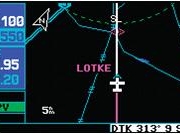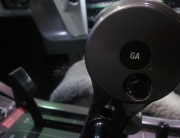I remember one day getting one of the best compliments of my flying career. I had just battled strong, gusty crosswinds and a little bit of windshear, and finally welcomed with relief the sound of one of my main tires touching the pavement. Then the other. The battle was over. As I was helping my clients unload their luggage and carry them out, I crossed the chief flight instructor of the local flight school. She simply asked me: ”Was it you that landed the airplane?” As I aquiesqued, she continued ”It’s got to be the best text-book crosswind landing I’ve seen!” I could only smile in gratitude, for I know that I am far from a great pilot.. but eh, we all have our small victories.
(Read Part 1 of A landing you can walk away from – Runway Friction Index)
(Read Part 2 of A landing you can walk away from – Hydroplaning)
The fact remains, though, that crosswind landings will always be part of our day to day operations. It’s one of the first techniques you learn after learning how to land in flight school. After that, it’s mostly up to you to put your knowledge and skills together and fly the airplanes entrusted to you during your career as best you can, making sure that every landing is a good landing. But hold on a minute! Knowledge? Skill? Where can I buy those? Man I wish there was a price, but sadly, they are both things aquired over time and experience. Skill, you can only get by practice and practice and… practice. Knowledge, on the other hand, is readily available and easy to come by in most cases.Put the two together, and often if skill lacks, knowledge can help balance the equation. Let me demonstrate… 🙂
CROSSWINDS
Adverse wind conditions (i.e., strong crosswinds, tail winds and wind shear) are involved in 33 % of approach-and-landing accidents. Crosswind in association with runway condition is a circumstantial factor in nearly 70 % of runway excursion events. 85 % of crosswind incidents and accidents occur at landing.
Design Factors [1]
There are many factors which will affect or limit your ability to deal with a crosswind, despite your skills. It is a good thing to be aware of them:
Aircraft geometry limitation: This limitation reflects the maximum pitch attitude and/or bank angle that can be achieved without incurring a tail strike or scrapping the engine nacelle, the flaps or the wingtip (as applicable).
Ailerons / rudder authority: This limitation reflects the aircraft maximum capability to maintain a steady sideslip under crosswind conditions.
Geometry limits usually are not a concern in high crosswinds as the roll and rudder authority is reached before any aircraft-to-ground contact occurs. This assumes achieving a steady sideslip without overcontrol (i.e., without excessive rudder and roll inputs) during the decrab / align phase.
Know what is safe [2]
 Landings in certain crosswind conditions are inadvisable or even dangerous. If the crosswind is great enough to warrant an extreme drift correction, a hazardous landing condition may result. Therefore, the landing capabilities with respect to the reported surface wind conditions and the available landing directions must be considered.
Landings in certain crosswind conditions are inadvisable or even dangerous. If the crosswind is great enough to warrant an extreme drift correction, a hazardous landing condition may result. Therefore, the landing capabilities with respect to the reported surface wind conditions and the available landing directions must be considered.
Before an airplane is type certificated […], it must be flight tested to meet certain requirements. Among these is the demonstration of being satisfactorily controllable with no exceptional degree of skill or alertness on the part of the pilot in 90° crosswinds up to a velocity equal to 0.2 VSO. This means a wind speed of two-tenths of the airplane’s stalling speed with power off and landing gear/flaps down.
The headwind component and the crosswind component for a given situation can be determined by reference to a crosswind component chart. It is imperative that pilots determine the maximum crosswind component of each airplane they fly, and avoid operations in wind conditions that exceed the capability of the airplane.
(You can read up more about runway conditions and crosswind charts on Part 1 of this series)
Techniques
Final Approach
Wether you are a student pilot or flying commercial jets for a living, the technique you use on final approach to counter cross wind comes down to two options: “Crabbing” or “Sideslipping“. Pilots and experts differ on their preferences in the matter for multiple reasons.
The FAA, for example, recommends the use of the sideslip all the way through the final approach, as it allows for a smoother transition in the flare and requires less skill and coordination from the pilot. Airbus, on the other hand, favours a crabbed approach due to airplane geometry. Some pilots or even airlines will also advocate for crabbed approaches as they are a lot better for passenger comfort.
Airframe manufacturers consider the following factors when recommending a wingslevelor a steady-side-slip approach:
- Aircraft geometry (i.e., pitch attitude and bank angle limits for preventing tail strike,engine nacelle contact or wingtip contact)
- Ailerons (roll) and rudder (yaw) authority
- Crosswind component.
Here are the two methods, as described by the FAA [2]
The crab method is executed by establishing a heading (crab) toward the wind with the wings level so that the airplane’s ground track remains aligned with the centerline of the runway. This crab angle is maintained until just prior to touchdown, when the longitudinal axis of the airplane must be aligned with the runway to avoid sideward contact of the wheels with the runway.
The wing-low (sideslip) method will compensate for a crosswind from any angle, but more important, it enables the pilot to simultaneously keep the airplane aligned with the runway centerline throughout the final approach, roundout, touchdown, and after-landing roll.Align the airplane with the centerline of the runway, note the rate and direction of drift, and then promptly appliy drift correction by lowering the upwind wing.
I found that Airbus’ [1] depiction added a little bit of understanding, allowing for a better idea of control input and instrument readings. It also clearly states their position on the recommended technique.
Flare
Not withsdanting the technique used during your final approach, the flare and touchdown part of the landing will most likely remain the most demanding part of the manoeuvre. The goals to achieve throughout the landing are to eliminate any side-loading and maintain the aircraft alignment with the runway centerline.
If you used the sideslip all the way down your final segment, little adjustment will be required during the flare. The most you will have to adjust is the amount of aileron needed to maintain centerline alignment depending on wind strenght/gust during flare.
If you used the crab method, you will need to redress the nose of the airplane during flare and transition to a sideslip during flare. This will ensure a minimum sideloading and centerline alignment. Some bigger airplanes face geometry limitations (wing span, engine size/emplacement) which do not allow them to bank more than a given amount to counter drift, and so are required to accept a modicum of sideloading while maintaining a slight crab angle throughout touchdown. Most light aircrafts will encounter a total loss of control authority before facing a geometry problem.
During flare, do not level the wings; keep the upwind wing down throughout the roundout. If the wings are leveled, the airplane will begin drifting and the touchdown will occur while drifting. Remember, the primary objective is to land the airplane without subjecting it to any side loads that result from touching down while drifting.
In a single engine, always remember that the P-Factor will also add to the need for more RIGHT rudder as the angle of attack increases during the flare and your nose will naturally tend to pull left.
Touchdown and Rollout
You may think the battle is over once the wheels have finally all made contact with the ground. Far from true. As the airplane decelerates, forces start to switch and swivel dramatically. The headwind airflow caused by the aircraft’s forward movement is reduced (taking away control authority), and the lateral push of the crosswind forces begin their insiduous work on every part of your airplane. Airbus created a great summary of the knowledge to have concerning this part of the landing:
Upon touchdown of the main landing gear, the aircraft transitions from the “ laws of flight dynamics” to the “ laws of ground dynamics”. The following are among the events that occur upon touchdown:
• Wheels rotation, unless hydroplaning is experienced. To minimize the risk of hydroplaning and ensure a positive spin up of wheels, it is recommended to perform a firm touchdown when landing on a contaminated runway.
• Buildup of friction forces between the wheel tires and the runway surface, under the combined effect of wheels/tires-braking forces
Effect of Touchdown on Alignment
When touching down with some crab angle on a dry runway, the aircraft automatically realigns with the direction of travel down the runway. On a contaminated runway, the aircraft tends to travel along the runway centerline with the existing crab angle.Effect of Fuselage and Fin Side Force
As the aircraft touches down, the side force created by the crosswind component on the fuselage and fin tends to make the aircraft skid sideways (downwind) off the centerline.Effect of Thrust Reversers
When selecting reverse thrust with some crab angle, the reverse thrust results into two force components:• A stopping force aligned along the aircraft direction of travel (runway centerline), and
• A side force, perpendicular to the runway centerline, which further increases the tendency to skid sideways.The thrust reverser effect decreases with decreasing airspeed. As airspeed decreases, the rudder efficiency decreases and is further affected by the airflow disruption created in the wake of the engine reverse flow, possibly resulting in difficulties to maintain directional control
Effect of Braking
In a high crosswind, cross-controls may have to be maintained after touchdown to prevent the into-wind wing from lifting and to counteract the weathercock effect. However, into-wind aileron decreases the lift on the into-wind wing, thus resulting in an increased load on the into-wind landing gear. Because the friction force increases as higher loads are applied on the wheels and tires, the braking force increases on the into-wind landing gear, creating an additional tendency to turn into-wind
Common errors in the performance of crosswind approaches and landings are:
• Attempting to land in crosswinds that exceed the airplane’s maximum demonstrated crosswind component.
• Inadequate compensation for wind drift on the turn from base leg to final approach, resulting in undershooting or overshooting.
• Inadequate compensation for wind drift on final approach.
• Unstabilized approach.
• Failure to compensate for increased drag during sideslip resulting in excessive sink rate and/or too low an airspeed.
• Touchdown while drifting.
• Excessive airspeed on touchdown.
• Failure to apply appropriate flight control inputs during rollout.
• Failure to maintain direction control on rollout.
(Read Part 1 of A landing you can walk away from – Runway Friction Index)
(Read Part 2 of A landing you can walk away from – Runway Friction Index)









Leave A Comment